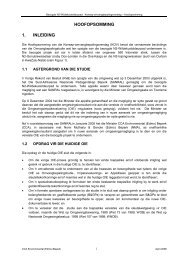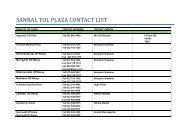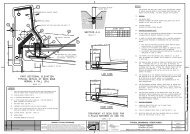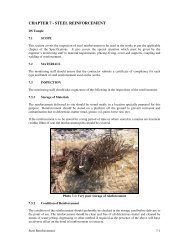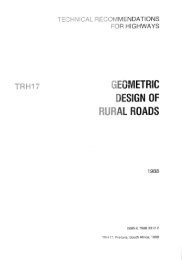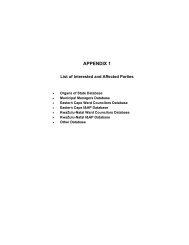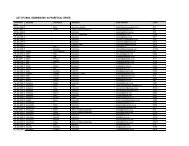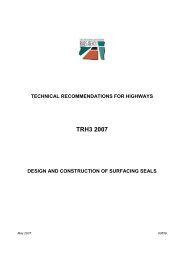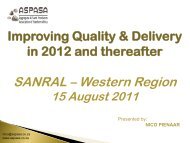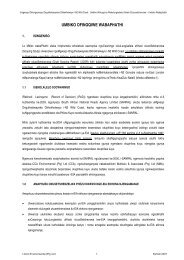SAPEM Chapter 2 - Sanral
SAPEM Chapter 2 - Sanral
SAPEM Chapter 2 - Sanral
You also want an ePaper? Increase the reach of your titles
YUMPU automatically turns print PDFs into web optimized ePapers that Google loves.
South African Pavement Engineering Manual<br />
<strong>Chapter</strong> 2: Pavement Composition and Behaviour<br />
12. VARIABILITY<br />
Designing a pavement is not an exact science because of all of the variability. This variability occurs in four<br />
predominant areas:<br />
Materials:<br />
Random variability exists in all materials, which is apparent when viewing quality and strength results.<br />
Behaviour of materials is complex, resulting in variability in the form of random error.<br />
The tests that are used do not entirely simulate field conditions and follow simplified protocols, thus<br />
introducing more variability in the form of systematic error.<br />
Material models are simplified for expedience and thus unable to fully capture complex material behaviour,<br />
resulting in more variability and uncertainty.<br />
Climate:<br />
Temperature varies diurnally and seasonally, and prediction models are not exact.<br />
Moisture varies seasonally and regionally, and prediction models are also not exact.<br />
Weathering is a function of climatic conditions and material properties, which are both variable.<br />
Durability phenomena that influence performance, e.g., oxidation of binders and carbonation of stabilisers,<br />
change with climate and time and are co-dependent on many other factors, e.g., voids in an HMA mix.<br />
Traffic:<br />
Axle loads and wheel loads are not constant.<br />
Tyre pressure, contact stresses at the surface, and contact area are all variable so the stresses experienced<br />
by the road materials are not constant.<br />
Traffic speeds, which influence the response of some materials, are variable.<br />
Models to take account of different traffic loads, e.g., damage factor calculations and equivalent standard axle<br />
loads, are over-simplified.<br />
Construction:<br />
Layer thicknesses in the pavement structure must meet specification requirements, but are nevertheless<br />
variable.<br />
Compaction of layers must meet specification requirements, but the achieved density is still variable.<br />
Laboratory simulations of material behaviour cannot exactly simulate construction behaviour, thus introducing<br />
systematic error.<br />
It is important to take account of variability in a pavement during the design. A design that uses average results for<br />
all of the input variables will have 50% reliability when the design life is reached. In addition, it is important to<br />
reduce variability wherever possible, which can be achieved through improved quality management during the<br />
material investigation phase, construction and testing. This limits the occurrence of failures under in-service<br />
conditions.<br />
At this point, it is opportune to introduce the concept of reliability. Reliability is a measure of precision, e.g., high<br />
reliability of results implies high precision, and low random error, which is part of variability. Reliability does not<br />
imply accuracy, however. Accuracy is the validity of the results, i.e., how closely do they resemble reality? For<br />
example, high accuracy implies high validity and low systematic error, which is part of variability. In pavement<br />
design, reliability is used to assess the confidence of a design. In important roads, high design reliability is required,<br />
typically 90 to 95%. This ensures the likelihood of premature failure is<br />
reduced. See also <strong>Chapter</strong> 10, Section 3.2.<br />
Precision vs Accuracy<br />
Accuracy is the degree of<br />
closeness of measurements to<br />
the actual value. Precision is the<br />
reproducibility or repeatability of<br />
the measurements.<br />
Section 12: Variability<br />
Page 35





